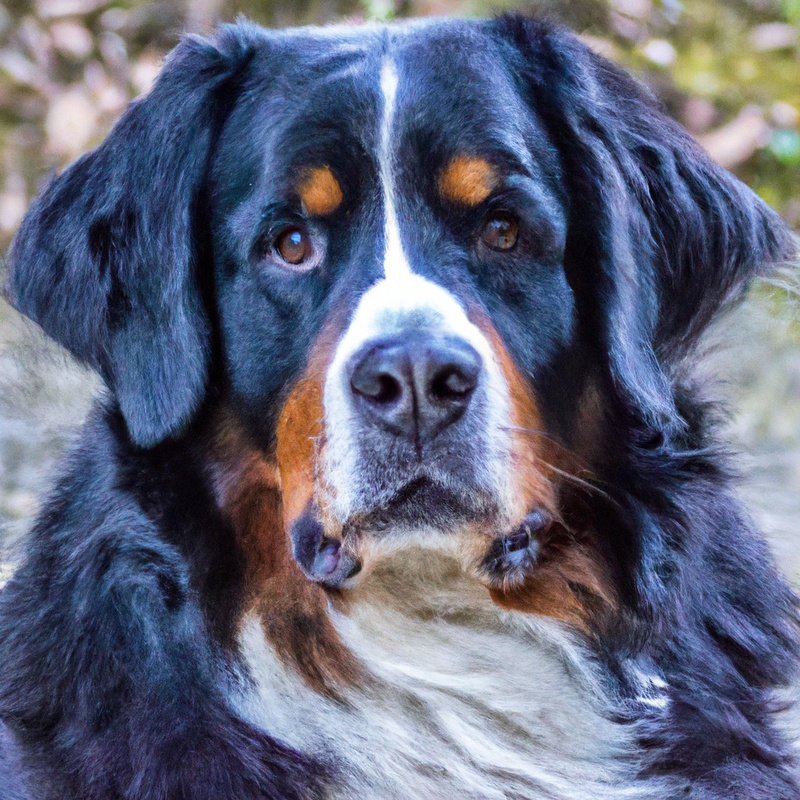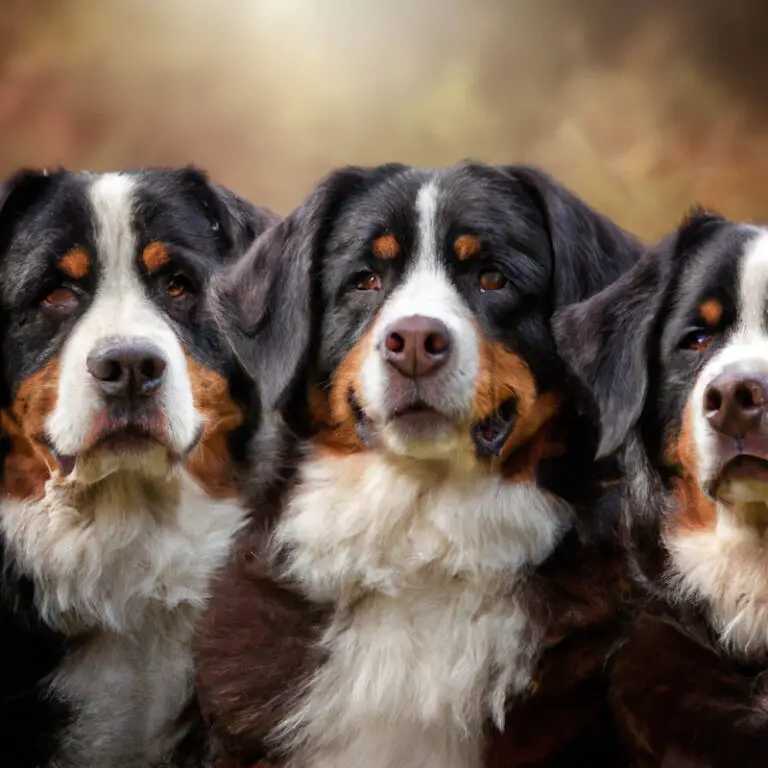How To Train a Bernese Mountain Dog Effectively?
Key Takeaways:
- Consistency and positive reinforcement are key in effectively training a Bernese Mountain Dog.
- Start training your Bernese Mountain Dog from an early age to establish good behaviors.
- Focus on socialization to ensure your Bernese Mountain Dog is comfortable around people and other animals.
- Regular exercise and mental stimulation are important for keeping your Bernese Mountain Dog happy and well-behaved.
Are you ready to embark on a training journey with your Bernese Mountain Dog? These magnificent creatures require more than just love and attention; they need proper guidance and structure to bring out their best behavior.
As a proud Bernese Mountain Dog owner, I understand the importance of an effective training regimen.
In this blog article, I’ll guide you through the ins and outs of training your Bernese Mountain Dog effectively. From understanding their unique physical traits and temperament to mastering basic commands and tackling behavioral issues, we’ll cover it all.
Get ready to create a harmonious bond with your furry companion as we dive into the world of Bernese Mountain Dog training.
| Training Method | Description |
| Positive Reinforcement | Uses rewards, such as treats and praise, to reinforce desired behaviors and discourage unwanted behaviors. Focuses on rewarding good behavior rather than punishing bad behavior. Can include clicker training and treats. |
| Clicker Training | A form of positive reinforcement training that uses a clicker to mark desired behaviors. The clicker sound is paired with a reward to reinforce the behavior. |
| Leash Training | Teaches the dog to walk on a leash without pulling. Involves teaching the dog to respond to leash cues and rewarding good leash manners. |
| Basic Commands | Teaches the dog basic commands such as sit, stay, down, come, and leave it. Focuses on clear communication and consistent training sessions. |
| Socialization | Exposes the dog to new people, animals, and environments to help them develop good social skills. Involves controlled and positive experiences to reduce fear and anxiety. |
Understanding the Bernese Mountain Dog Breed
Physical Traits and Temperament
The Bernese Mountain Dog is a large and sturdy breed with a distinctive tri-colored coat consisting of black, white, and rust.
They have a strong, muscular build and a friendly expression.
These dogs have a gentle and affectionate temperament, and they are known for being great family pets.
They are patient and get along well with children and other animals.
However, they can be a bit reserved with strangers, which makes them excellent watchdogs.
Training a Bernese Mountain Dog requires patience and consistency, but their eager-to-please nature makes them quick learners.
Socialization from a young age is also important to help them develop into well-rounded dogs.
Exercise and Mental Stimulation Needs
Exercise and Mental Stimulation Needs: Bernese Mountain Dogs have high exercise and mental stimulation needs to keep them happy and healthy. Regular exercise, such as daily walks or playtime in a secure area, is essential to prevent boredom and behavior problems.
Engaging them in activities like obedience training, puzzle toys, and interactive games can provide the mental stimulation they crave.
Additionally, socializing them with people and other animals helps keep their minds sharp and prevents loneliness. Remember, a well-exercised and mentally stimulated Bernese Mountain Dog is a happy one.
Preparing for Training
Establishing a Routine
To establish a routine for training your Bernese Mountain Dog effectively, start by setting consistent times for feeding, exercise, and potty breaks. This will help your dog understand what to expect and when.
Make sure to include regular training sessions in your routine, focusing on specific commands or behaviors you want to teach.
Be consistent with your expectations and rewards. Lastly, create a calm and structured environment for your dog, providing them with a designated space and clear boundaries.

Creating a Positive Training Environment
Creating a positive training environment is essential for effectively training a Bernese Mountain Dog. Here are some key tips:
- Choose a quiet and distraction-free location to conduct training sessions.
- Use positive reinforcement techniques, such as treats and praise, to motivate your dog.
- Keep training sessions short and engaging to avoid boredom.
- Be patient and consistent in your training approach.
- Establish clear boundaries and rules to provide structure for your dog.
By creating a positive atmosphere, you’ll optimize your dog’s learning experience and ensure successful training sessions.
Equipment and Supplies Needed
To effectively train a Bernese Mountain Dog, you’ll need a few essential equipment and supplies. Here’s what you’ll need:
- A sturdy leash and collar: Choose a leash and collar that are comfortable and secure for your dog. A harness may be a good option for Bernese Mountain Dogs, as it helps distribute their weight evenly.
- Treats: Use high-quality, tasty treats as rewards during training sessions. These will help motivate your dog and reinforce positive behavior.
- Clicker: A clicker is a great tool for marking the desired behavior and signaling to your dog that they have done something right. It can be a useful aid in training.
- Training mat or crate: A training mat or crate can provide a designated space for your dog to learn and relax. It’s important to have a comfortable and safe area for them.
- Toys: Incorporating toys into training sessions can make the learning process more enjoyable for your Bernese Mountain Dog. Interactive toys can help keep their minds engaged.
Remember, it’s important to have the right equipment and supplies to ensure effective training sessions with your Bernese Mountain Dog.

Basic Training Commands
Sit, Stay and Lie Down
Training your Bernese Mountain Dog to sit, stay, and lie down is essential for their obedience and safety. To teach the “sit” command, hold a treat above their head and slowly move it back towards their tail.
As they naturally follow the treat with their nose, their bottom will lower into a seated position.
Pair this action with the verbal command “sit” and reward them with the treat. For “stay,” have your dog sit and then take a step back.
If they remain still, reward and praise them.
Gradually increase the distance and duration of the stay. To teach “lie down,” start with the sit command.
Hold a treat in front of their nose and then lower it straight down to the ground.
As they follow the treat with their nose, their body should flatten into a lying down position. Pair this with the verbal command “lie down” and reward them.
Consistency, patience, and positive reinforcement are key for successful training.

Come and Recall
Come and Recall are important commands to teach your Bernese Mountain Dog. To train them effectively, start in a distraction-free environment.
Use a clear and consistent command, such as “come” or “here.” Make it a positive experience by using treats or toys as rewards.
Practice in different locations with increasing distractions. Be patient and consistent in your training.
With time and practice, your dog will learn to come when called and have a reliable recall.
Leave It and Drop It
Leave It and Drop It are two important commands when training a Bernese Mountain Dog.
“Leave It” is used to teach the dog to leave something alone, while “Drop It” is used to have the dog release something from its mouth.
To train these commands, start with a treat and say the command when the dog shows interest.
When the dog looks away or drops the item on command, reward them.
Practice in different situations and gradually increase difficulty.
Always use positive reinforcement and be consistent to effectively train your Bernese Mountain Dog.
Socialization and Behavioral Training
Introducing Your Bernese Mountain Dog to Different Environments and People
Introducing your Bernese Mountain Dog to different environments and people is essential for their socialization. Start with gradual exposure, allowing them to explore at their own pace.
Introduce them to various surfaces, sounds, and sights to build their confidence.
Encourage positive interactions with people of all ages and different backgrounds. Reward their good behavior and provide a safe and positive experience.
Regular exposure will help them become well-rounded and adaptable companions.
Desensitization to New Stimuli
Desensitization to new stimuli is an essential part of training for Bernese Mountain Dogs.
To help your dog adjust to unfamiliar sights, sounds, and experiences, gradually expose them to these stimuli in a controlled and positive manner.
Start with low-intensity encounters and gradually increase the intensity over time.
Use treats and praise to reinforce positive behaviors and create positive associations.
Consistency and patience are key in desensitizing your Bernese Mountain Dog to new stimuli.
Addressing Common Behavior Issues
Addressing common behavior issues in Bernese Mountain Dogs can be challenging but not impossible.
Here are some effective strategies:
- Consistent Training: Establish clear rules and boundaries from the beginning.
- Positive Reinforcement: Reward good behavior with treats, praise, and playtime.
- Socialization: Expose your dog to various people, animals, and environments to prevent aggression and fearfulness.
- Exercise and Mental Stimulation: Engage your dog in daily physical activity and provide stimulating toys to prevent boredom and destructive behavior.
- Patience and Persistence: Changing behavior takes time, so be patient and consistent in your training efforts.
Training for Advanced Skills
Leash Walking and Loose-leash Training
When it comes to leash walking and loose-leash training, there are a few key things to keep in mind.
First, start training your Bernese Mountain Dog at a young age to get them accustomed to walking on a leash.
Use positive reinforcement and rewards to encourage good behavior.
Second, practice patience and consistency during your training sessions.
Keep the leash loose and encourage your dog to walk beside you without pulling.
Third, consider using a front-clip harness or head collar to help discourage pulling.
With practice and consistency, your Bernese Mountain Dog can become a great walking companion!
Off-leash Training and Advanced Recall
Off-leash training and advanced recall are important aspects of training for a Bernese Mountain Dog.
To train your dog for off-leash control, start by teaching basic obedience commands like “sit,” “stay,” and “come.” Gradually increase distractions and practice in different environments.
For advanced recall, use positive reinforcement and rewards to encourage your dog to come to you reliably and quickly.
Practice consistently and gradually increase the difficulty of the distractions.
Proper training and reinforcement will help ensure a strong off-leash recall for your Bernese Mountain Dog.
Tricks and Agility Training
Tricks and agility training are great ways to engage and challenge your Bernese Mountain Dog. Start with simple tricks like sit, stay, and lie down, gradually progressing to more advanced tricks like shake hands and roll over.
For agility training, set up obstacles like jumps, tunnels, and weave poles.
Remember to use positive reinforcement and rewards to motivate your dog. Consistency and patience are key when training your Bernese Mountain Dog in tricks and agility.
Happy training!
Maintaining Training Consistency
Practicing Regularly
Practicing regularly is key when training your Bernese Mountain Dog. Consistency is important for them to learn and retain commands.
Set aside dedicated time each day for training sessions.
Keep the sessions short and engaging, around 10-15 minutes. Reinforce positive behavior with rewards and praise.
Stay patient and consistent with your training approach.
Regular practice will help establish a strong bond with your dog and ensure effective training results.
Reinforcing Positive Behaviors
Reinforcing positive behaviors is essential when training a Bernese Mountain Dog. Here are a few tips to help you reinforce positive behaviors effectively:
- Use positive reinforcement: Reward your dog with treats, praise, and affection when they exhibit the desired behavior. This helps them associate positive outcomes with good behaviors.
- Be consistent: Consistency is key. Reward your dog every time they display the desired behavior, and ignore or redirect them when they engage in unwanted behaviors.
- Timing is important: Make sure to praise and reward your dog immediately after they exhibit the desired behavior. This helps them understand what they’re being rewarded for.
- Be patient and persistent: Training takes time and effort. Continue to reinforce positive behaviors consistently, even if they don’t catch on right away. With patience and persistence, your Bernese Mountain Dog will respond positively.
Remember to keep training sessions short and enjoyable for your dog. By using positive reinforcement and being consistent, you’ll effectively reinforce positive behaviors and help your Bernese Mountain Dog become a well-behaved, happy companion.
Addressing Regression or Challenges
Addressing regression or challenges in training a Bernese Mountain Dog can be frustrating, but it’s important to stay patient and consistent.
If you notice your dog regressing in training, go back to the basics and reinforce the commands they have already learned.
Use plenty of positive reinforcement and rewards to motivate and encourage your dog.
It’s also helpful to vary the training environment and incorporate distractions gradually to help your dog generalize their training to different situations.
Seek professional help if needed, and remember that every dog learns at their own pace.
Frequently Asked Questions
What age should I start training my Bernese Mountain Dog?
You can start training your Bernese Mountain Dog as early as 8 weeks old.
This is a good age to start because puppies are like sponges, eager to learn and please their owners.
Begin with basic commands like sit, stay, and come.
Use positive reinforcement techniques such as treats and praise to encourage good behavior.
Remember to keep training sessions short and fun to maintain your puppy’s attention and motivation.
Be consistent and patient, and your Bernese Mountain Dog will surely become a well-behaved companion.
How long does it take to train a Bernese Mountain Dog?
Training a Bernese Mountain Dog typically takes several months to a year, depending on the dog’s age, temperament, and previous training experience.
Consistency, patience, and positive reinforcement techniques are essential for successful training.
Regular training sessions, socialization, and ongoing reinforcement of learned behaviors help ensure a well-behaved and obedient Bernese Mountain Dog.
It’s important to remember that each dog is unique, so the training duration may vary.
What are some common mistakes to avoid during training?
One common mistake to avoid during training your Bernese Mountain Dog is inconsistency.
Dogs thrive on routine and consistency, so it’s important to establish a regular training schedule and stick to it.
Another mistake is using punishment-based methods.
Positive reinforcement is a much more effective and humane approach to training.
Additionally, avoid overtraining or pushing your dog too hard.
Keep training sessions short and engaging to prevent burnout.
Finally, don’t forget to socialize your dog.
Exposing them to different environments, people, and animals will help them become well-rounded and confident.
Final Verdict
Training a Bernese Mountain Dog effectively requires understanding their physical traits, establishing a routine, and creating a positive training environment. Basic commands such as sit, stay, lie down, recall, leave it, and drop it are essential.
Socialization and behavioral training should focus on introducing them to different environments and people, desensitizing them to new stimuli, and addressing common behavior issues.
Advanced skills like leash walking, off-leash training, and tricks can also be taught. Consistency is key, with regular practice and reinforcement of positive behaviors.
By avoiding common mistakes and addressing challenges, you can create a well-behaved and happy Bernese Mountain Dog.








